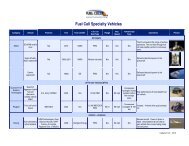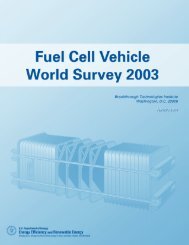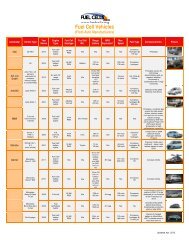Breakthrough Technologies Institute - Fuel Cells 2000
Breakthrough Technologies Institute - Fuel Cells 2000
Breakthrough Technologies Institute - Fuel Cells 2000
You also want an ePaper? Increase the reach of your titles
YUMPU automatically turns print PDFs into web optimized ePapers that Google loves.
Web: www.governor.state.tx.us/divisions/ecodev<br />
Texas Energy Center<br />
www.txec.org<br />
The Texas Energy Center is a consortium of private companies and public sector entities<br />
working together to advance Texas’s potential as a leader in energy-related innovation<br />
and commerce. Specific focus areas are ultra-deepwater, petroleum exploration and<br />
production applications; advanced natural gas technologies; clean coal, hydrogen and<br />
next generation “zero emissions” power plants; advanced automotive fuels and<br />
infrastructure (including low sulfur gasoline, clean diesel, biofuels, natural gas, hydrogen<br />
and hydrogen blends); fuel cells; and wind power. The Energy Center has been partially<br />
funded through the Texas Enterprise Fund. As a condition of the funding agreement, the<br />
Center has committed to creating 1,500 new jobs in Texas by 2009 and maintaining<br />
these jobs until 2019. Fort Bend County and the city of Sugar Land have also provided<br />
funding to the Energy Center.<br />
Contact:<br />
Texas Energy Center<br />
Web: www.txec.org<br />
8. STATE AND LOCALLY-SUPPORTED DEMONSTRATIONS<br />
Dallas/Fort Worth International Airport: A 5-kW fuel cell-powered, uninterrupted<br />
power source (UPS) system was used to provide uninterrupted power at the Dallas/Fort<br />
Worth International Airport‘s (DFW) central plant. Phone lines downloaded all utility<br />
operational data, and the Texas State Energy Conservation Office has access to this<br />
database for real-time monitoring of natural gas, water and electric consumption<br />
production and consumption activity of the fuel cell.<br />
CAM Station, Houston: In 2001, the Texas Commission on Environmental Quality<br />
conducted a project to power all the equipment in a continuous air monitoring station<br />
using fuel cell technology. Powered by a 3-kW fuel cell, Phase I demonstrated the use<br />
of hydrogen to power the CAM station and Phase II involved the use of a reformer to<br />
convert propane–natural gas into electricity. The fuel cell project was an effort among<br />
several organizations including the Port of Houston, the Texas Railroad Commission and<br />
the Texas State Energy Conservation Office.<br />
Texas Department of Transportation, San Antonio: This Texas Commission on<br />
Environmental Quality project demonstrated the first propane-to-hydrogen fuel processor<br />
integrated with a fuel cell to supply electrical power to the grid. Using a Plug Power 5kW<br />
PEM fuel cell, this project operated from January-April 2004, producing electricity to<br />
feed into the grid at the Texas Department of Transportation TransGuide Intelligent<br />
Transportation System in San Antonio. Project partners included City Public Service,<br />
San Antonio; Railroad Commission of Texas; State Energy Conservation Office; Texas<br />
Commission on Environmental Quality; Texas Department of Transportation; and DOE.<br />
206






